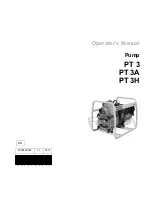
8
254 and 254OS Pneudraulic Installation Tools (HK1172)
Disassembly
This procedure is for complete disassembly of the tool.
Disassemble
only
those components necessary to replace
damaged O-rings, Quad-rings, Back-up rings, and worn
and damaged components. For component identification,
see Figures 1–4 & 9–11.
1. Disconnect the tool from the air source.
2. Remove the nose assembly per the instructions on
Nose Assembly Data Sheet
.
3. Insert the Fill Tool (P/N
112465
) through the reservoir
housing and screw it into the reservoir plunger, locking
it in the out position. (Figure 1)
4. Unscrew the 4 cap screws with a 5/32” hex key, and
carefully separate the head from the handle. Remove
the pull and return gland assemblies; remove the seals
from the glands.
5. Unscrew the relief valve plug from the front of the
head. Then remove the spring, guide, ball, and sleeve.
A small magnet is helpful.
6. Unscrew the reservoir fill plug from the side of the
head. Slowly release the fill tool, and drain the fluid
into a container. (Figure 1) Discard the fluid.
7. Unscrew the reservoir housing. Then remove the two
springs, and slide reservoir plunger out of the head.
Remove the spacer and use a “pick” to remove the
Quad-ring.
8. Unscrew the check valve plug from the side of the
head. Then remove the spring, guide, and ball. (Figure
1)
If check valve seat is damaged, contact your Huck
representative.
If seat is damaged, it can be removed (through front of
tool head) by using the following procedure. NOTE:
If seat is removed, it cannot be reused; it must be
replaced.
Seat removal: Remove all parts in the reservoir check
valve before removing plug. Unscrew plug, insert a
#10 screw in the thread of plug, and pull to remove.
Use a small drift and hammer and, from the rear
side of the head, drive seat out towards the front of
the head.
9. Pull the pintail deflector off the end cap (254 only). Use
a 1-3/4” open-end wrench to unscrew the end cap.
Slide out the spring.
10. Slide Spacer onto the piston. Thread the
Piston
Assembly Tool
onto the piston. (Figure 2) Push the
piston out the back of the head. Allow clearance as
piston leaves the tool.
NOTE
:
This will push out the
front and rear gland assemblies, the wiper, and
wiper housing. (Figure 9)
Bleed Plug Assembly
(Reservoir Fill Plug)
Reservoir Plunger
Spring(2)
Quad-Ring
Reservoir
Housing
Spacer
112465 Fill
Tool Assembly
Fill Tool in the
Lock-Out Position
Plug
Screw
Pull Gland Assembly
Return Gland Assy
(see Figure 9)
Cap Screws (4)
Handle Assembly
Spring
Check Valve Ball
Check Valve Guide
Relief Valve Sleeve
Relief Valve Ball
Relief Valve Guide
Spring
Relief Valve Plug Assembly
Cylinder Head Assembly
(see Figure 9)
Cylinder Cap
Deflector
Check Valve Plug
Figure 1
WARNING: Disconnect the air hose from the
tool before performing any maintenance.
Serious personal injury could result if the air
hose is connected.
CAUTION: DO NOT scratch the piston or
cylinder when removing.
continued...




































